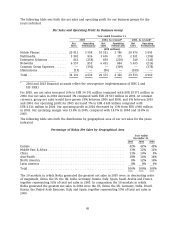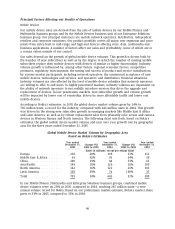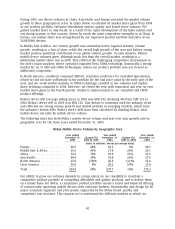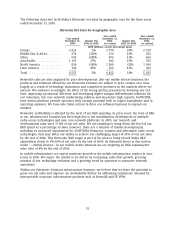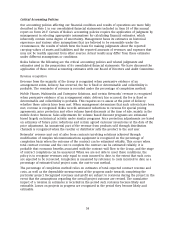Nokia 2005 Annual Report Download - page 57
Download and view the complete annual report
Please find page 57 of the 2005 Nokia annual report below. You can navigate through the pages in the report by either clicking on the pages listed below, or by using the keyword search tool below to find specific information within the annual report.Networks’ customer contracts may include the provision of separately identifiable components of a
single transaction, for example the construction of a network solution and subsequent network
maintenance services. Accordingly, for these arrangements, revenue recognition requires proper
identification of the components of the transaction and evaluation of their commercial effect in
order to reflect the substance of the transaction. If the components are considered separable,
revenue is allocated across the identifiable components based upon relative fair values.
Networks’ current sales and profit estimates for projects may change due to the early stage of a
long-term project, new technology, changes in the project scope, changes in costs, changes in
timing, changes in customers’ plans, realization of penalties, and other corresponding factors.
Customer financing
We have provided a limited amount of customer financing and agreed extended payment terms
with selected customers in our Networks business. In establishing credit arrangements,
management must assess the creditworthiness of the customer and the timing of cash flows
expected to be received under the arrangement. However, should the actual financial position of
our customers or general economic conditions differ from our assumptions, we may be required
to re-assess the ultimate collectibility of such financings and trade credits, which could result in a
write-off of these balances in future periods and thus negatively impact our profits in future
periods. Our assessment of the net recoverable value considers the collateral and security
arrangements of the receivable as well as the likelihood and timing of estimated collections. See
also Note 38(b) to our consolidated financial statements for a further discussion of long-term loans
to customers and other parties.
Allowances for doubtful accounts
We maintain allowances for doubtful accounts for estimated losses resulting from the subsequent
inability of our customers to make required payments. If the financial conditions of our customers
were to deteriorate, resulting in an impairment of their ability to make payments, additional
allowances may be required in future periods. Management specifically analyzes accounts
receivables and analyzes historical bad debt, customer concentrations, customer creditworthiness,
current economic trends and changes in our customer payment terms when evaluating the
adequacy of the allowance for doubtful accounts.
Inventory-related allowances
We periodically review our inventory for excess, obsolescence and declines in market value below
cost and record an allowance against the inventory balance for any such declines. These reviews
require management to estimate future demand for our products. Possible changes in these
estimates could result in revisions to the valuation of inventory in future periods.
Warranty provisions
We provide for the estimated cost of product warranties at the time revenue is recognized. Nokia’s
products are covered by product warranty plans of varying periods, depending on local practices
and regulations. While we engage in extensive product quality programs and processes, including
actively monitoring and evaluating the quality of our component suppliers, our warranty
obligations are affected by actual product failure rates (field failure rates) and by material usage
and service delivery costs incurred in correcting a product failure. Our warranty provision is
established based upon our best estimates of the amounts necessary to settle future and existing
claims on products sold as of the balance sheet date. As we continuously introduce new products
which incorporate complex technology, and as local laws, regulations and practices may change, it
55


